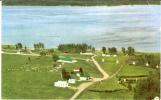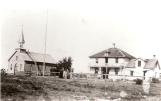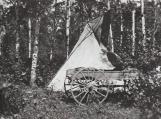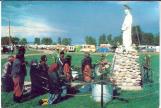1
In 1842, Father Thibault decided to create a permanent mission for the Métis people. He knew there were many French-Indians who needed to be married, baptized, and instructed in the ways of the Church. "Devil's Lake", the English translation of the name given to the lake by the local natives, was a central location with good fertile fields, tall trees for lumber, and plenty of fish and wildlife. It was also far enough away from the Hudson Bay politics found at Fort Edmonton.On September 8, 1842, Father Thibault and Father Bourassa moved into the newly constructed home without doors or windows and with a dirt floor. The building would serve as the Church until one could be constructed. This was done the following year.
That same day in September, Father Thibault renamed the lake "Lac Ste. Anne" in honour of his patron saint, Saint Anne.
So began the Mission of Lac Ste. Anne. The Fathers began the teachings of the church and also taught the people how to farm. They had predicted the demise of the buffalo and wanted to make the Métis people self-sufficient. By 1859 the Mission boasted 17 fat and fine cows, 15 horses, 10 dogs, 10 cats, and a garden with flowerbeds. Pigs and sheep were not raised because of the dogs and wild predators. Crops included wheat, barley, cabbage, onions, and turnips. The Mission supplied Fort Edmonton with the majority of their food.
In 1859, three Grey Nuns make the arduous journey from Montreal to the Mission. They were the third, fourth, and fifth white women to travel to Alberta. On September 24, Lac Ste. Anne welcomed these three brave women with enough mud to bog down their wagon at the entrance to the Mission. The Sisters began their lives here by learning the Cree language, starting a school, helping in the gardens, and painting the windows of the Church so that worshippers would not be distracted by the beauty outside during worship services.
The Mission grew until it was over 2000 people. The Hudson Bay store, a separate school, an orphanage retreat, a North West Mounted Police barracks, a dance hall, a post office, several stores, saloons, and hotels moved into the area complimenting the Church, Rectory, and convent. At one time, this Mission was larger in population and commerce than Fort Edmonton.
Father Lacombe, who arrived in 1842, was a priest filled with vision and a great deal of common sense. In 1861, he decided for many sound reasons to build a new mission at St. Albert. When he left, the Lac Ste. Anne Mission was almost deserted by pastors and flock. All that was left were a few homes, the Church and Rectory, the Nun's Residences, and the Shrine.
Lac Ste. Anne has, since the time of the Plains Indians, been reported to be an instrument of healing. As far back as 1889, the Fathers recorded healings of various ailments, from general sickness to tuberculosis, gout, or paralysis, that the waters of Lac Ste. Anne were reported to cure. Testimony is displayed in the shrine in the form of crutches and canes no longer needed by the owners. Today, over 40,000 pilgrims from all over the world come to the lake to attend the annual pilgrimage held during the third week in July, many walking miles barefoot as penance, to witness or be part of the miracle of healing. Priests, Bishops, and Cardinals all come to help people in the curing of physical and spiritual ailments. Oaths of Sobriety, along with other lifestyle promises, are made.
7
Aerial View of the Mission at Lac Ste. Anne, AlbertaLac Ste. Anne, Alberta
 Credits:
Credits:Imprimerie La Survivance Printing, Edmonton, Alberta





